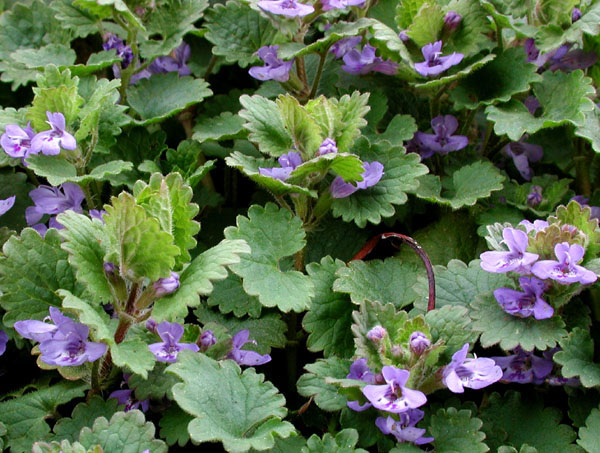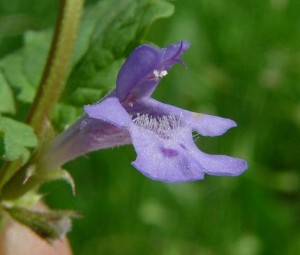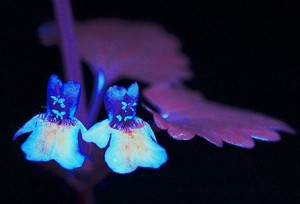Most of the time when someone mentions Ground Ivy the comment usually is something like “How do I get rid of the damned stuff?” Here at ETW we have have the solution.
Ground Ivy, Glechoma hederacea, is a creeping perennial that roots at the nodes and smells similar to mint when crushed or mowed. It’s a prime weed of turfgrass and landscapes. If you like well-behaved Engish type gardens then Ground Ivy will drive you insane because it may be small but it’s the Botanical Bull in the China Shop. It doesn’t take over, it takes command. While there are no look alikes — if you look closely enough — there are four species which from some distance might be mistaken for Ground Ivy. It is often misidentified as a Common Mallow (Malva neglecta), but the square stem of Ground Ivy distinguishes it from the Common Mallow which has a round stem. Henbit (Lamium amplexicaule), Purple Deadnettle (Lamium purpureum) and Persian Speedwell (Veronica persica) are somewhat similar in appearance to Ground Ivy, but none of them have creeping stems that root at the nodes. Of these four all but the Persian Speedwell are edible.
Ground Ivy, once known as Nepeta glechoma and Nepeta hederacea in the Catnip genus, is a native of Europe and southern Asia. It was introduced into North America by 1672, probably earlier, for medicinal uses. Gound Ivy moved west and was naturalized in Indiana by 1856 and Colorado by 1906. How and exactly when it was distributed is not known. While it concentrates in the deciduous and riparian forests of the Northeast and around the Great Lakes it is now found throughout North American except for the desert southwest (New Mexico, Arizona, Nevada) and the three top tier northwest Canadian Providences (the Yukon, Northwest Territories, Nunavut.) It also surprisingly missing on the east end of the continent from the islands of Saint Pierre and Miquelon.
Don’t know where Saint Pierre and Miquelon are? This is your lucky geographic day: The islands are situated at the entrance of Fortune Bay off the southern coast of Newfoundland. They are not part of Canada but still part of France, a leftover toehold in the New World from colonial days. Residents are French citizens and vote in French election though the home county is more than 4,000 miles to the east. It was from these islands that a large amount of Canadian whisky was smuggled into the United States during prohibition. Makes you think they should have called it French Whisky, or at least French Canadian Whisky.
Though you may think Ground Ivy’s botanical name has some Scottish influence it’s totally Mediterranean…well, almost. Glechoma is latinized Greek, or in this case very bastardized Greek for pennyroyal. The Greek word is Βλήχων, said VLEE-kon, yes, with a V. How that got mangled into gleh-KOH then gleh-KOH-ma is any linguistic guess. This also why the genus spelled Glechoma and Glecoma because there is no agreement on how to translate the Greek X into Dead Latin or English. The X is close, though, to the CH as in a Scottish “loch” but not as hard. Hederacea (head-er-ah-SEE-uh) is Dead Latin for “like ivy” read creeping. When all put together it kinds of means Pennyroyal Ivy. Common names include Alehoof, Catsfoot, Field Balm, Run-Away-Robin, Lizzie-Run-Up-The-Hedge, Herbe St. Jean, occasionally Creeping Charlie — which is the name of many plants — and Gill-Over-The-Ground, the latter perhaps being the most common after Ground Ivy. “Alehoof” means “ale herb” a time when Ground Ivy was used like hops.
While humans can consume it within reason ground Ivy is toxic to horses in large amounts.
Green Deane’s “Itemized” Plant Profile: Ground Ivy
IDENTIFICATION: Glechoma hederacea: Flowers usually in clusters of three in the axils, the area between the stem and petiole. Flowers blue-violet, 3/8 to 5/16 inch long. Leaves are opposite, nearly round or occasionally kidney-shaped, on long petioles. Edges scalloped, large rounded teeth. Leaf veins rise from the same point. Stems square, trailing, rooting at the nodes, mostly hairless but with occasional short, stiff backward-pointing hairs. Seed, tiny nutlets, egg-shaped and brown in color. Each flower produces four seeds.
TIME OF YEAR: In cooler climes blooms later spring to early summer. Here in Florida it is a spring and fall plant, avoiding the hot summer. In Canada it can be found September to November.
ENVIRONMENT: Thrives in moist not saturated shaded areas, but will also tolerate sun. Common plant in grasslands, wooded areas disturbed ground, around damns. Because of rooting at the nodes it survives mowing, is found in lawns and around buildings. Has no particular soil requirements but is difficult to permanently remove from any soil other than very loose.
METHOD OF PREPARATION: While it is in the greater mint family Ground Ivy is not a gentle mint as many are. Use very young Ground Ivy for greens and soup et cetera, older leaves for tea and medicinal applications. Fresh or dried leaves are used for herbal tea, bitter, young shoots and leaves eaten like spinach, cooked in soups which they flavor, try first. The Saxons added it to their beer for flavor like hops, to clarify the beer, and add shelf life. It is very high in iron.
Herb Blurb
A 1986 study found that Ground Ivy’s ursolic and oleanolic acids inhibited the Epstein-Barr virus and protected mouse skin from induced tumor growth. A 1991 study showed the species fatty acid stimulated enzyme activity in blood platelets. Traditionally it was used to treat sciatica, ringing in the ears, constipation caused by lead poisoning, kidney disorders, indigestion, coughs, and tuberculosis. Animal research has not supported its use for cough. Leaves, dried or fresh was stuffed up the nose to relieve headaches.





